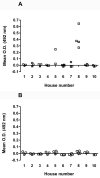Anti-triatomine saliva immunoassays for the evaluation of impregnated netting trials against Chagas disease transmission
- PMID: 21426907
- PMCID: PMC3118394
- DOI: 10.1016/j.ijpara.2011.02.001
Anti-triatomine saliva immunoassays for the evaluation of impregnated netting trials against Chagas disease transmission
Abstract
Insecticide-impregnated nets can kill triatomine bugs, but it remains unclear whether they can protect against Chagas disease transmission. In a field trial in Quequeña, Peru, sentinel guinea pigs placed in intervention enclosures covered by deltamethrin-treated nets showed significantly lower antibody responses to saliva of Triatoma infestans compared with animals placed in pre-existing control enclosures. Our results strongly suggest that insecticide-treated nets prevent triatomine bites and can thereby protect against infection with Trypanosoma cruzi. Anti-salivary immunoassays are powerful new tools to evaluate intervention strategies against Chagas disease.
Copyright © 2011 Australian Society for Parasitology Inc. All rights reserved.
Figures



Similar articles
-
Impregnated netting slows infestation by Triatoma infestans.Am J Trop Med Hyg. 2008 Oct;79(4):528-34. Am J Trop Med Hyg. 2008. PMID: 18840739 Free PMC article.
-
Periurban Trypanosoma cruzi-infected Triatoma infestans, Arequipa, Peru.Emerg Infect Dis. 2006 Sep;12(9):1345-52. doi: 10.3201/eid1209.051662. Emerg Infect Dis. 2006. PMID: 17073082 Free PMC article.
-
Kissing bugs. The vectors of Chagas.Adv Parasitol. 2011;75:169-92. doi: 10.1016/B978-0-12-385863-4.00008-3. Adv Parasitol. 2011. PMID: 21820556
-
Allergic reactions to Triatoma bites.Ann Allergy Asthma Immunol. 2003 Aug;91(2):122-8; quiz 128-30, 194. doi: 10.1016/S1081-1206(10)62165-5. Ann Allergy Asthma Immunol. 2003. PMID: 12952105 Review.
-
Insecticide resistance in vector Chagas disease: evolution, mechanisms and management.Acta Trop. 2015 Sep;149:70-85. doi: 10.1016/j.actatropica.2015.05.014. Epub 2015 May 21. Acta Trop. 2015. PMID: 26003952 Review.
Cited by
-
Characterization of guinea pig antibody responses to salivary proteins of Triatoma infestans for the development of a triatomine exposure marker.PLoS Negl Trop Dis. 2014 Apr 3;8(4):e2783. doi: 10.1371/journal.pntd.0002783. eCollection 2014 Apr. PLoS Negl Trop Dis. 2014. PMID: 24699441 Free PMC article.
-
Serological responses and biomarker evaluation in mice and pigs exposed to tsetse fly bites.PLoS Negl Trop Dis. 2014 May 22;8(5):e2911. doi: 10.1371/journal.pntd.0002911. eCollection 2014 May. PLoS Negl Trop Dis. 2014. PMID: 24853371 Free PMC article.
-
Distribution of triatomine species in domestic and peridomestic environments in central coastal Ecuador.PLoS Negl Trop Dis. 2017 Oct 2;11(10):e0005970. doi: 10.1371/journal.pntd.0005970. eCollection 2017 Oct. PLoS Negl Trop Dis. 2017. PMID: 28968383 Free PMC article.
-
Human antibody response to Aedes albopictus salivary proteins: a potential biomarker to evaluate the efficacy of vector control in an area of Chikungunya and Dengue Virus transmission.Biomed Res Int. 2014;2014:746509. doi: 10.1155/2014/746509. Epub 2014 Apr 13. Biomed Res Int. 2014. PMID: 24822216 Free PMC article.
-
Heterogeneous infectiousness in guinea pigs experimentally infected with Trypanosoma cruzi.Parasitol Int. 2016 Feb;65(1):50-54. doi: 10.1016/j.parint.2015.09.009. Epub 2015 Oct 22. Parasitol Int. 2016. PMID: 26432777 Free PMC article.
References
-
- Amato Neto V. Origin of the “Y strain” of Trypanosoma cruzi. Rev Inst Med Trop Sao Paulo. 2010;52:171. - PubMed
-
- Amino R, Tanaka AS, Schenkman S. Triapsin, an unusual activatable serine protease from the saliva of the hematophagous vector of Chagas disease Triatoma infestans (Hemiptera: Reduviidae) Insect Biochem Mol Biol. 2001;31:465–472. - PubMed
-
- Camargo ME, Rebonato C. Cross-reactivity in fluorescence tests for Trypanosoma and Leishmania antibodies. A simple inhibition procedure to ensure specific results. Am J Trop Med Hyg. 1969;18:500–505. - PubMed
-
- Drame PM, Poinsignon A, Besnard P, Le Mire J, Dos-Santos MA, Sow CS, Cornelie S, Foumane V, Toto JC, Sembene M, Boulanger D, Simondon F, Fortes F, Carnevale P, Remoue F. Human antibody response to Anopheles gambiae saliva: an immuno-epidemiological biomarker to evaluate the efficacy of insecticide-treated nets in malaria vector control. Am J Trop Med Hyg. 2010;83:115–121. - PMC - PubMed
Publication types
MeSH terms
Grants and funding
LinkOut - more resources
Full Text Sources
Medical

